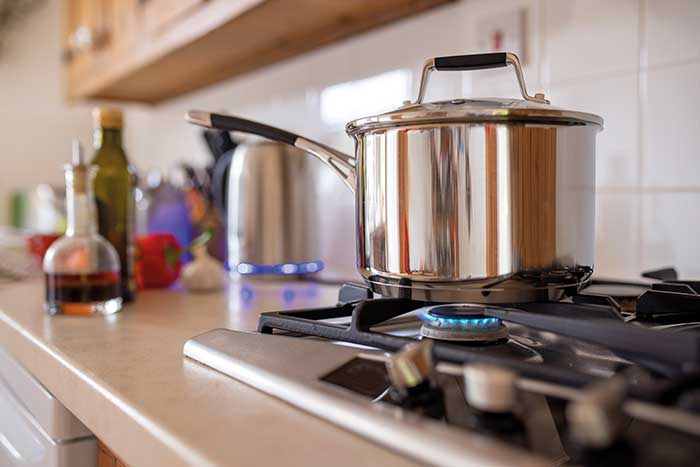Learn how to prevent condensation - and what we can do to help if it’s a bigger issue
It’s important that you ring us if you have a severe damp or mould problem, so we can help identify the underlying causes and what action can be taken.
There’s always moisture in the air, even if you can’t see it. Most moisture in your home is created by everyday activities like washing, cooking, bathing – even breathing.
Condensation occurs when warm, moist air (such as steam from a kettle), comes into contact with cool air or a cool surface (such as window panes and around external door and window frames). Water droplets form when the cool air or surface reduces the temperature of the warm, moist air, turning it from gas to liquid.
It can also appear where air circulation is restricted (such as inside cupboards or behind furniture placed against an outside wall).
As warmer air holds moisture better, a colder home will also release more moisture to these surfaces.
The common areas for condensation are the kitchen, the bathroom and the bedroom.
Condensation is also formed in new homes as the materials used in constructing them (such as mortar and plaster) dry out gently over time.

Condensation occurs when excess moisture in the air settles on cold surfaces. If not wiped away or ventilated, it can create ideal conditions for black mould growth.
Mould thrives on condensation and commonly appears in moisture-prone areas like bathrooms and kitchens. It can also develop on cold surfaces such as windows, walls, external door and window frames, where ceilings meet outer walls, inside cupboards, behind furniture, and even on bedding or clothing.
Reducing excess moisture in your home lowers the risk of condensation mould.
Mould can damage your home and pose health risks, especially for those with asthma or respiratory conditions. Breathing in large quantities of mould spores can lead to health issues, so it’s important to address mould promptly.
In addition to treating existing mould, you can reduce future risks by managing condensation effectively. This includes optimising heating (thermostats and programmers), improving ventilation (windows, fans, and extractor systems), and controlling moisture levels in your home.
There are several types of damp and they each have different causes:
Penetrating damp
This is caused by water seeping through the walls, often due to a leak or faulty roofing. If you think your home may have penetrating damp, we’re here to help – call us as soon as you can, so we can arrange a home visit and find the right solution.
Rising damp
This is more of a rare occurrence but can cause a ‘tide mark’ (or horizontal line) to travel up your wall. This means that groundwater could be getting in, usually due to a damaged damp proof course. If you think you have rising damp, don’t worry - call us as soon as you can, and we’ll investigate it for you and work quickly to resolve things.
If you’re a homeowner, shared owner or leaseholder, you’re normally responsible for the repairs and maintenance of your home but please speak to us in case any problems are due to a structural issue that we are responsible for.
If you rent from us, we treat all reports of condensation, damp, and mould as either an emergency or a priority repair.
Under Awaab's Law, we also have to address all damp and mould hazards that present a significant risk of harm to tenants within fixed timeframes.
- If you tell us about damp and mould in your home, we'll ask you some important questions to assess your situation. If it's an emergency, we will make an appointment within 24 hours - otherwise it will be scheduled as soon as possible but within 10 working days. In either case, we will talk about the next steps (any work needed and timescales) with you.
- We want your home fixed quickly but it may take time to identify the cause of damp and mould. Please be aware it can involve multiple visits and a process of elimination. After our initial visit, if additional work is required, we'll send a report containing a plan of action, explaining the works needed and timescales.
Please call us as soon as possible if you notice persistent damp or mould, and we’ll work with you to resolve it.
Condensation isn’t normally a building fault but, if you’ve tried to reduce the moisture in your home and it’s not working, or if you have a problem with severe condensation or mould, call us and we’ll help as soon as possible.
If you have excess condensation, we can help. Simple things like fitting trickle vents in your windows for constant air flow, or installing extractor fans in your kitchen and bathroom, can make a big difference. We will also be able to carry out a mould wash.
If excess condensation is causing mould, act immediately to prevent further damage.
How to treat mould
- Clean affected areas with a fungicidal wash (available at supermarkets and DIY stores). Follow safety instructions.
- Monitor the area for a week; if mould returns, reapply the treatment.
- Dry clean affected clothing or carpets to remove mould spores.
- Avoid brushing or vacuuming mould as this can spread spores and worsen respiratory risks.
- Use fungicidal paint when redecorating to help prevent regrowth. If wallpapering, use a fungicidal paste - avoid wallpaper in bathrooms.
Preventing mould from returning
- Control condensation by reducing excess moisture in your home (see our tips on reducing condensation).
- Ensure proper ventilation, using extractor fans and keeping vents clear.
- Maintain even heating to avoid cold surfaces where condensation can form.
- Wipe away condensation daily to prevent moisture build up.
If you continue to experience mould despite following these steps, call us so we can help assess and resolve the issue.
Follow our tips to reduce excess moisture that can lead to mould in your home

Reduce the moisture produced
- Cooking: Use lids on saucepans and don’t leave kettles boiling. Open windows or use extractor fans.
- Bathing: Run cold water before hot when filling a bath—this reduces steam by 90%. Keep bathroom doors closed and windows open.
- Drying clothes:
- Dry clothes outside when possible.
- If drying indoors, use an airer rather than radiators.
- The bathroom is usually best if it has a fan or a slightly open window.
- Avoid drying clothes in bedrooms, as moisture can build up overnight.
- Tumble dryers: Ensure vented dryers are properly vented outside. If using a condensing dryer, open a window.
- Heaters: Avoid paraffin and portable gas heaters, as they produce excess moisture and pose safety risks.
Improve ventilation
- Use extractor fans in kitchens and bathrooms—if they’re not humidity-controlled, check if they require the light to stay on.
- Open trickle vents in windows and keep them clear.
- Avoid draught-proofing kitchens and bathrooms, as these rooms need ventilation.
- Keep interior doors closed when cooking or showering to prevent moisture from spreading.
- Ventilate bedrooms at night by leaving a window or door slightly open.
- Unblock air vents and air bricks to ensure airflow.
- Leave space behind furniture and avoid overfilling cupboards to improve air circulation.
Manage condensation daily
- Keep your home above 15°C to prevent cold surfaces where condensation forms.
- Wipe down condensation from windows and sills every morning. Dry and wring out the cloth after use.
- Use moisture absorbers (e.g., disposable traps with absorbent crystals or DIY alternatives like a bowl of rock salt or cat litter in a sock).
Following these steps will help keep your home dry, comfortable, and mould-free. If issues persist, call us for further assistance.

- Wipe away condensation with a dry cloth and wring it out afterward. Open a window or use an extractor fan to let moisture escape.
- Ventilate in the morning by briefly opening windows to replace humid air from overnight breathing with drier outdoor air.
- Before cooking, bathing, or showering, open a window or use an extractor fan. Keep doors closed to prevent moisture from spreading.
- Run extractor fans continuously - never turn them off, as moisture will stay trapped in your home.
- Keep window trickle vents
open, even in winter, for continuous airflow. Ensure other vents remain clear.
- If you have a positive input ventilation (PIV) unit
(such as Vent-Axia PoziDry Pro), let it run automatically - it’s energy-efficient and helps reduce moisture.
- For homes with a mechanical ventilation heating system, (MVHR), follow the user manual to ensure proper ventilation. call us if you need help.
- Position furniture away from walls (about two inches) to allow air circulation.
- Avoid overcrowding cupboards, wardrobes, and drawers to promote airflow.
- Keep clothing and bedding off room corners to prevent moisture build up.
Following these steps will help keep your home dry, comfortable, and mould-free.

- Heat your home in advance: Ensure your home is warm before activities like showering, cooking, or washing, as moist air from these activities will settle on cold surfaces and cause condensation.
- Maintain a consistent temperature: Keep your home warm enough to avoid cold surfaces. Heating it gradually helps prevent condensation, as buildings can take time to warm up.
- Set your heating to pre-emptively start about an hour before getting up or returning home. Avoid turning it on only when you wake up.
- During very cold weather, it’s better to keep the heating on at a lower setting throughout the day, rather than turning it off completely.
- Heat all rooms to prevent cold areas. It’s more effective to maintain a low temperature in unused rooms than to heat some rooms excessively while others are cold.
- If you no longer need certain rooms, contact us about potentially moving to a smaller, more energy-efficient home.
- Roof condensation: Some moisture may form on roof felt during cold weather as warm, moist air meets cold surfaces. This usually disperses naturally but contact us if you're concerned.
- Conserve heat: Close curtains at dusk to reduce heat loss by 15-17% and use draught excluders to retain warmth.
We understand it's not always possible to heat your home as much as you'd like. Please check out the other information on this page about sources of support and advice if you need them.
*The government suggests keeping your living areas at 18-20 degrees when you're at home (bedrooms can be a bit cooler at night). To avoid major condensation problems, the temperature shouldn’t drop below 14 degrees.
Tips to avoid condensation, damp and mould when you're heating your home
Learn how to heat your home efficiently while reducing condensation. This video covers smart heating habits and simple ways to maintain a balanced indoor temperature to help prevent damp.
Tips to avoid condensation, damp and mould when you're drying the washing
Drying laundry indoors can lead to excess moisture. This video shares tips on how to dry clothes safely—whether you're using a clothes airer or tumble dryer—without encouraging mould growth.
Tips to avoid condensation, damp and mould when you're cooking
Cooking can release a lot of moisture into the air. Watch this video for easy ways to ventilate your kitchen, use extractor fans effectively, and keep damp at bay while you prepare meals.
Tips to avoid condensation, damp and mould when you have a bath or shower
Bathrooms are prime spots for mould. This video shows how to manage steam, use ventilation properly, and keep surfaces dry after bathing or showering to prevent damp from taking hold.
If you need these videos in a different format, please get in touch and we’ll be happy to help.
South and West - 0300 5000 926 - 8am and 6pm weekdays. Outside of these times, our Out of Hours team is available for emergencies.
London and East - 0300 373 3000 - 8am and 6pm weekdays.



